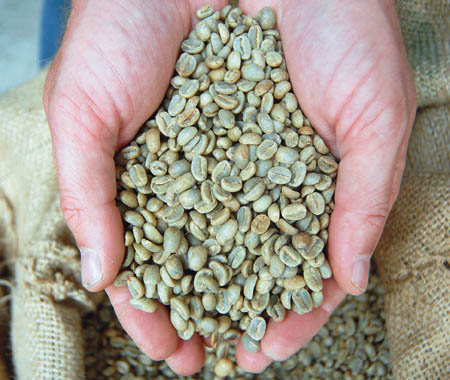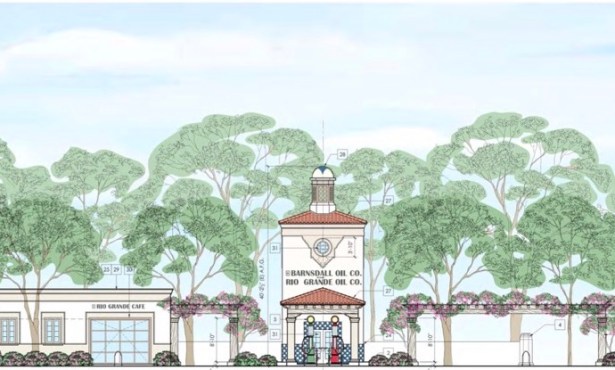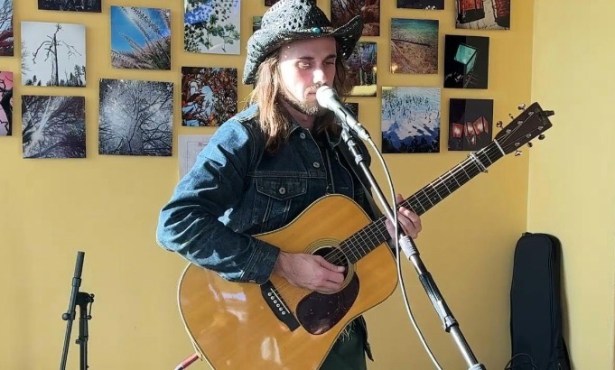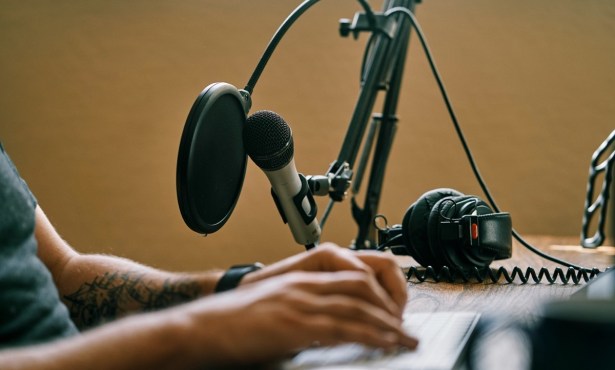Bean Counting

When Dan Randall first started coffee roasting 15 years ago, it was with one intention-to create the kind of gourmet, organic coffee he loved. His girlfriend at the time was unimpressed. “She didn’t like my stuff,” Randall said recently. “Her idea of a good cup of coffee was Farmer Brothers. If it didn’t taste like a brown paper bag brewed through a gym sock, she didn’t like it.”
In 1992, it would likely have been Randall’s girlfriend, not Randall, whose preferences reflected most American coffee drinkers. Coffee was then considered first and foremost a stimulant-if it tasted okay and provided a kick in the pants, it was good enough. A comparative lack of coffee shops in town reflected this: The Green Dragon was great, and so was the cafe in Earthling Books; Vices & Spices is still trucking along. But they didn’t have a whole lot of competition, and anyway, that was Santa Barbara. What was Kansas City like in the early ’90s? “Latte” probably was not part ofthe vernacular.
Things change. Today, Red Star Coffee, the Santa Barbara-based roasting house Randall owns with his business partner Kevin Donnelly, is flourishing. Gourmet, organic, and other specialty coffees take up a sizable chunk of the world coffee market, where 15 years ago they were relegated to parts of Europe and, in the U.S., a few enclaves on the East and West seaboards. And the trend isn’t just about taste-it’s about lifestyle.
Perhaps the purest manifestation of this specialty coffee craze-both the search for better taste and the notion that coffee is more than just a beverage-is fair-trade coffee. Fair trade includes a number of different roasts; tying them together is a system of non-governmental commerce that (in theory) results in better working conditions and more money predominantly for the developing world’s coffee growers. Fair trade is now the fastest growing specialty coffee.
To many consumers, fair trade represents a perfect union between good coffee (almost all of it is organic and high grade) and good politics-with a sip of Guatemalan fair-trade coffee, you can help a struggling farmer put food on the table. “If you have the choice to buy coffee that tastes great and is socially and environmentally responsible, and it costs maybe 25 cents more a cup, are you?” asked Kevin Bourke, owner of Hair Raiser Coffee, a Santa Barbara roasting house. “Of course you are.” Hair Raiser, along with Red Star Coffee, sell fair-trade roasts, and area coffee shops Coffee Cat, Vices & Spices, Reds, NorthStar Coffee Co., and Muddy Waters offer customers fair-trade brews (only Coffee Cat is exclusively fair trade).
Selling fair trade makes sense in Santa Barbara, where social equity issues tend to enjoy a high premium.
But what about parts of the country where Human Rights Watch and the Surfrider Foundation don’t have chapters? “If you count on everyone to [buy fair-trade] because of their ideological commitments, you’re going to be stuck in a niche market that doesn’t serve a broad range of people,” said Matt Warning, a development economist and professor at the University of Puget Sound, where he specializes in issues involving fair trade. But taste and the trend in quality coffee would seem to rescue fair trade from the curse of the niche market, which makes it natural for anyone in the coffee business, including large corporations, to take interest in it. Wal-Mart, through its grocery subsidiary Sam’s Club, now sells fair trade, as does Dunkin’ Donuts, Procter & Gamble, Sara Lee, Nestle, McDonald’s, and Starbucks.
Yet even as fair trade’s popularity is burgeoning, so is criticism. Increasingly, longtime grassroots fair traders are calling into question how well fair-trade coffee is living up to the ideal it promotes. They point to disgruntled farmers, bureaucratic rigidity, and the growing bond between fair-trade coffee and multi-conglomerate corporations. This last issue rankles especially; the marriage of Wal-Mart and fair trade, critics say, is of commerce and convenience, not ethics, and, the same people claim, it violates the principles upon which fair trade was founded.
Whether the fair-trade movement, such as it is, manages to resolve the various issues now assailing it, or whether it proves to be just another well-meaning trend that slowly loses heat, has broad implications. It is widely accepted that the axle upon which the global economy now spins-“free trade”-has a troubling tendency to exclude and exploit citizens of the developing world in ways that benefit those in developed countries. When governments, individually and through agencies like the World Trade Organization, try to address this, their efforts are often cumbersome and ineffective. Fair trade, its advocates argue, offers a way for developed countries’ consumers to directly achieve what their governments often can’t or won’t, which is a more equitable, “fair” way of doing business with the people who make many of the products we enjoy.
What Is Fair Trade?
Conceptually present for at least 50 years in the U.S. and Europe, fair trade has gone through a number of incarnations. Only in the last five or 10 years has it achieved mainstream success, thanks largely to a concerted publicity campaign by an international coalition of labeling and certifying organizations. The basic mission statement of the fair-trade movement is that developing-world producers who meet certain criteria should receive a “fair” wage for the fruits of their labor. To that end, fair-trade organizations work to cut out middlemen who suck up profits, and establish cooperatives through which developing-world producers can (in theory) exercise more autonomy and leverage more power in negotiations with developing countries’ consumers. Making this all possible is a labeling system by which fair-trade vetted products such as coffee, tea, chocolate, and bananas get a fair-trade certified logo slapped on them, and consumers pay a little more to drink, eat, or even walk in them (there are fair-trade shoes).
Since 1997, fair trade has been effectively governed by Fairtrade Labelling Organizations International (FLO), a Bonn, Germany-based association of 20 national labeling organizations around the world. FLO is responsible for appraising production sites in Latin America, Africa, and Asia where fair-trade products are grown and produced, while organizations such as TransFair USA-the national labeling organization for North America-certify the actual buying and selling of fair-trade products, ensuring that fair-trade standards are upheld at every link in the supply chain.
As the world’s second-most legally traded commodity (by value) after oil, coffee takes the lion’s share of the fair-trade market. Coffee roasters generally sell fair-trade beans to coffee shops at a higher rate because fair-trade beans cost more than standard beans. Still, many coffee shops don’t charge more for fair-trade brews. For example, the owners of Coffee Cat, Krista Fritzen and Jason Womack, charge similar prices for their coffee as other cafes, despite the fact that Coffee Cat carries exclusively fair-trade coffee. “When we made the decision to carry fair-trade I think we were less business-oriented and more idealistic, being first-time business owners,” Fritzen said. “And yes, the margin isn’t as good as it is with industrial coffee.”
The question of whether to charge more for fair-trade coffee is fraught for cafe owners in part because many (if not most) customers don’t know what the fair-trade label signifies, which means when they look at the menu and see higher prices for coffee, that’s all they see-a latte that costs $3.15 instead of $2.85. Still, Fritzen has reason to hope: According to a study by the National Coffee Association conducted in 2006, 20 percent of Americans know about fair trade, and of those, 56 percent say they are willing to buy a product based exclusively on its fair-trade status. And that’s in the U.S.-fair trade is considerably more popular in Europe.
Fair trade’s formative stages coincided with the political tumult that wracked much of Latin America in the 1980s; many of fair trade’s earliest advocates first became interested in issues of economic equity while living in or observing places like Nicaragua under the Sandinistas and El Salvador during the late ’80s and early ’90s. Coffee cooperatives-coalitions of hundreds of small farms, each with a single vote in the cooperative’s governance-were deemed the best way to enact the fair-trade philosophy. They would give developing-world farmers a voice, a more powerful negotiating base, and a whiff of democracy in the midst of various autocracies.
Today the cooperatives are one of the most controversial aspects of fair trade. FLO sets certification standards for fair trade, which range from pesticide use to labor conditions. The most significant standard is the rule that a coffee grower must be part of a small family farm that is itself part of a larger democratic cooperative, known as the smallholder rule. This means a land-owning farmer who refuses to join a cooperative, even if he/she has impeccable growing standards and good employee relations, will not be able to participate in the fair-trade system.
“The cooperative system can end up discriminating against people who uphold the values of the fair-trade movement, but who happen to be part of bigger farms, or just don’t want to join a cooperative,” said Lawrence Solomon, director of the Energy Probe Research Foundation, a Toronto-based firm that analyzes trade and consumer issues. Because of the popularity of specialty coffees, developing-world growers from Latin America to Africa are turning more and more to organic and shade-grown farming methods. But they are not always apt to embrace the fair-trade cooperative system, if doing so means they will have to produce smaller amounts of coffee-due to the smallholder rule-and will have to exchange autonomy for the whims of the cooperative. Additionally, as Solomon pointed out, in parts of Africa, coffee is grown along tribal lines, opening fair trade to charges of cultural imperialism.
Even if cooperatives function exactly as they’re meant to, and FLO’s certification process proceeds flawlessly, there’s still the issue of what to pay coffee growers who are certified as fair trade. According to many fair-trade advocates, the floor price of fair-trade coffee-that is, the minimum amount of money paid for a pound of coffee produced in accordance with fair-trade regulations-needs to change. Currently at $1.26 for coffee that meets only the basic fair-trade requirements and at $1.41 for coffee that is also organic and shade grown, the floor price hasn’t changed in 15 years. This seems less startling when you consider that both prices (because the great majority of fair-trade is organic, the second price-$1.41-predominates) are higher than the average for non-fair-trade coffee. And there’s also the fear many in the fair-trade movement feel toward pricing fair-trade coffee out of the market. The sentiment, according to Paul Rice, CEO and founder of TransFair USA, has been: “If we raise it [the price], we might kill the goose that’s laying the golden eggs.”
How Fair Is Fair Trade?
TransFair USA is an Oakland-based nonprofit with 30 employees. It has become, in the last few years, the focus of discussion about fair trade in the U.S., both good and bad. Advocates argue TransFair, with its aggressive marketing tactics, has done more than any other entity or person to spread the fair-trade brand in America, a point detractors generally don’t dispute. The question, critics say, is how TransFair has handled itself in balancing its dual role as an independent certifier and enthusiastic marketer of the fair-trade brand. By choosing to market the coffee, cocoa, bananas, and other commodities it’s supposed to be independently and objectively certifying for the benefit of trusting consumers, critics say, TransFair is courting a conflict of interest. “It’s like on one side of the covered wagon you’re creating awareness that snake oil is good for you and you’ve got to have snake oil,” said Larry Larson, owner of Larry’s Beans, a North Carolina-based roaster that sells 100 percent fair-trade coffee. “And on the other side of the wagon you’re saying, ‘Oh, and you can get it from me! And only this brand of snake oil works!'”
The focal point of such criticism is TransFair’s efforts to bring large corporations into the fair-trade fold-and the fact that TransFair refuses to distinguish the typically smaller, 100 percent fair-trade roasters like Larry’s Beans from massive ventures like Starbucks, which carries only 3.7 percent fair-trade coffee. “It’s natural that TransFair is going to [pursue large corporations] because it needs to get revenue. Its incentive is to certify as much coffee as possible so it can make its 10 cents a pound,” Larson said. (TransFair charges a licensing fee of 10 cents per pound of audited fair-trade coffee.) Tim Dominick, of Sacred Grounds, an Arcata, California-based roaster, put it this way: “If you’re collecting licensing fees from Sacred Grounds, that’s a few thousand dollars a year. If you’re collecting licensing fees from Starbucks, that’s a few thousand dollars a day.”
TransFair’s Rice was quick to rebut such charges. “No one’s making any money off this,” he said. “That’s just ridiculous. We are a certified nonprofit.” To Larson and others, however, the issue is not whether TransFair is making too much money-no one I spoke to made that particular charge-but rather, in its zealous pursuit of growth, that TransFair must inevitably favor large companies over small ones since large companies pay more licensing fees, which in turn allows for a wider marketing campaign.
Larson and other 100 percenters chalked up TransFair’s refusal to distinguish roasters by the percentage of fair-trade coffee they carry (for example, by creating a color-coded label system-gold for 100 percenters, silver for 50 percenters, etc.) to a fear of alienating larger clients who carry proportionally less fair-trade. Everyone I spoke with conceded the theoretical legitimacy of TransFair’s argument that the more fair-trade coffee sold-to whomever-the more benefit to growers. But in practice, they said, the consequence of such a come-one, come-all approach is the dilution of the social justice mission at the core of the fair-trade movement. “The people at TransFair have said from day one that the more fair-trade products that get sold, the better it is for the farmer, and I agree with that,” said Dean Cyon of Dean’s Beans, a Massachusetts-based 100 percent fair-trade roaster. “On the other hand, if there’s no differentiation between the 100 percenters and the dabblers, customers get a misreading of what’s going on, and it lessens the integrity of the label.”
“There are lots of roasters joining TransFair now when it’s a simple business decision,” said Sacred Grounds’ Dominick. “They have a market they can’t reach, and they join TransFair so they can reach that market. There’s nothing inherently wrong with that, but you have to question the motivation of some of these big corporations. Sam’s Club is doing fair trade now, and they’re part of Wal-Mart, which is notorious for mistreating their workers.” Dominick doesn’t believe only 100 percenters count -70 percent of Sacred Grounds’ coffee is fair-trade-but he does argue that carrying 5 percent or less fair-trade does not bespeak a true commitment to the welfare of the growers.
The Starbucks Factor
A fine test case for the issue of corporate participation in the fair-trade model is Starbucks. Ubiquitous from here to Tokyo, Starbucks can claim a generous slice of responsibility for the surge in popularity of specialty coffee. It’s also the subject of a great deal of discussion within the fair-trade movement. Black Gold, a recent documentary about the dismal living conditions of Ethiopian coffee farmers, more or less accuses Starbucks of exploiting Ethiopian labor (a great deal of Starbucks’s coffee is Ethiopian). So what does Starbucks have to say about suspicions voiced by some of the most committed members of the fair-trade movement? The response, provided by Andy Fouche, a company spokesman, was succinct: “Everyone is entitled to their opinion, but we are the largest purchaser of fair-trade coffee in North America. Eleven million pounds of our coffee in 2005 was fair-trade.”
Of course, if Starbucks claims to be a good corporate citizen, and yet only 3.7 percent of its coffee is fair-trade, one has to wonder about the rest of the load: Where does it come from, under what kind of conditions are its growers working, and how much are these workers being paid? According to Fouche, Starbucks has instituted a program called CAFE (Coffee and Farmer Equity) that is meant to act as an overriding ethical framework for the company. CAFE mandates similar trade measures as fair trade, including humane labor practices and transparent transactions. As for pay, Starbucks shelled out an average of $1.20 per pound of coffee in 2004, lower than the $1.26 floor price for fair-trade, but twice as much as the international average. Still, is CAFE just a way to bypass fair trade? “Well, that begs the question: Is fair trade the silver bullet for the coffee industry?” Fouche asked. “We absolutely believe it’s not.”
According to Fouche, the very nature of fair-trade coffee production excludes the possibility of 100 percent participation on Starbucks’s part. “Fair trade only certifies smallholder farms organized into cooperatives, and that represents about 2-3 percent of the world’s coffee farmers,” he said. “We support coffee on a global scale, and that means we buy not only from smallholder farms, but from medium- and large-scale farms and coffee estates, as well.”
Fouche’s argument-essentially, that fair trade is too narrow in its scope for a company the size of Starbucks-may not fully describe Starbucks’s relationship with fair trade, at least according to the University of Puget Sound’s Warning. “My gut feeling is Starbucks would be happy if fair trade didn’t exist,” Warning said. “Not because they are against the welfare of farmers, but because they’d have more freedom to do what they want without the constraint of fair trade.”
Still, Fouche has a point. Starbucks’s first priority is to buy quality coffee, and buy lots of it, something fair trade’s strictures may hinder. It is, in fact, possible that a little more freedom is just what the fair-trade movement needs; many believe it has become unduly rigid and not especially fair for the people it’s meant to help. As a result, there may be a curious convergence between Starbucks and Cooperative Coffees, the coalition of roasters dedicated to paying farmers more than the standard fair-trade price.
Cooperative Coffees now includes 21 different roasters, some of which-including Larry’s Beans and Dean’s Beans-are large operations with national distribution. Members of Cooperative Coffees buy beans certified by FLO, but lacking the certification-and the certification sticker-of TransFair. This can be confusing for consumers; if you go to the Web sites of any of these roasters, you will see beans advertised as fair-trade. Yet none have the little fair-trade emblem doled out to members of TransFair. In effect, this means you have to take Cooperative Coffees at its word that it’s paying more money for fair-trade brews; any roaster can buy coffee certified by FLO. Of course, it is exceedingly unlikely that coffee growers whose beans have been certified by FLO would sell them for less than the standard fair-trade floor price, and anyway, Cooperative Coffees doesn’t exactly seem like a scammer’s dream.
Does Free Trade Mean Fair Results?
Considering the many disputes swirling around it, and its rather labyrinthine vetting and certification process, it’s sometimes difficult to determine what exactly it means to buy a cup of fair-trade coffee. Moreover, in part because the fair-trade system is nongovernmental, consumers have to take it partly on faith that, for example, FLO is verifying farmers and cooperatives effectively.
A report by London’s Financial Times late last year found laborers at a number of Peruvian fair-trade certified farms were not even being paid the country’s minimum wage, despite being certified by FLO. And there is the fact that farmers who are not part of the fair-trade system but who produce high-quality, organic beans may charge more than $1.41 per pound-the fair-trade floor price for organic beans. This means going with fair-trade rather than other gourmet roasts does not necessarily ensure a better return for coffee farmers.
And yet, at the end of the day, there sits on the shelf two roasts: one that professes to be fair-trade, and one that does not. Which to choose? It seems reasonable to conclude that however the movement settles its differences, and whether it continues to flourish or it eventually founders, fair trade represents an example of systematic altruism, or social justice, or economic equity, or whatever you want to call it, that is impressive in its scope and pragmatism.
We take it on faith that an essential facet of capitalism is free trade: the notion that people and corporations should be allowed to conduct commerce-within reasonable bounds-free from government interference. Yet the perennial complaint that free trade has an inbuilt prejudice for those in power is a valid one, and one that fair trade attempts to correct in a way that is simple and requires nothing more than the free goodwill (and discerning taste buds) of its adherents. To revisit Hair Raiser Coffee’s Kevin Bourke: “If you have the choice to buy coffee that tastes great and is socially and environmentally responsible, and it costs maybe 25 cents more a cup, are you?”



